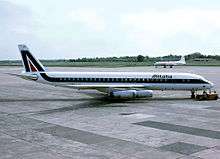Alitalia Flight 112
 An Alitalia Douglas DC-8 similar to the one of flight 112 | |
| Accident summary | |
|---|---|
| Date | 5 May 1972 |
| Summary | Pilot error, CFIT |
| Site | Mount Longa, near Palermo, Italy |
| Passengers | 108 |
| Crew | 7 |
| Fatalities | 115 (all) |
| Injuries (non-fatal) | 0 |
| Survivors | 0 |
| Aircraft type | Douglas DC-8-43 |
| Operator | Alitalia |
| Registration | I-DIWB |
| Flight origin | Fiumicino – Leonardo da Vinci International Airport (IATA: FCO, ICAO: LIRF), Rome, Italy |
| Destination | Falcone–Borsellino Airport (IATA: PMO, ICAO: LICJ), Palermo, Italy |
Alitalia Flight 112 was a scheduled flight from Leonardo da Vinci Airport, in Rome, Italy, to Palermo International Airport in Palermo, Italy, with 115 on board. On 5 May 1972, it crashed into Mount Longa, about 5 km (3 mi) south-west of Palermo while on approach. Investigators believe that the crew had 3 miles (4.8 km) visibility and did not adhere to the established vectors issued by air traffic control. It remains the deadliest single-aircraft disaster in Italy.
A memorial has been erected at the site of the crash.
The accident
On 5 May 1972, the aircraft I-DIWB of Alitalia (a Douglas DC-8-43) started the flight AZ 112 from Rome to Palermo, taking off 36 minutes late. Captain Roberto Bartoli, was in charge of the radio assistance, while First Officer Bruno Dini flew the aircraft. The times and locations have been precisely recovered from the recorder of Rome Control, which had a time recorder, while Palermo Approach did not.
The flight AZ 112 contacted Palermo Approach around 9:10 PM stating to be at 74 nautical miles (137 km) from VOR (which is installed on Mount Gradara, above the municipality of Borgetto, with a frequency of 112.3 MHz, around 10 miles (16 km) south of the airport of Punta Raisi).
Around 10:23–24 PM, the aircraft (coming from Ponente-lato Terrasini) hit a crest 935 meters (1,980 feet) high,[1] about 300 feet (91 m) below the top of the mountain, and slid for a long time on the ground with its wings, its fuselage, and its four engines, until it disintegrated in the successive hits against the rocks of the crest. Part of the debris and bodies of the victims rolled on the mountain side (Carini side) from where the kerosene fire was witnessed. The wreckage was strewn across a 2.5-mile (4.0 km) area, so wide it took rescue teams three hours to reach it. Later on, some witnesses at Carini said that they had seen the aircraft on fire before the crash.
Of the 115 passengers, almost all were Italian; the only known foreigners aboard were a Belgian stewardess and a French couple. The travelers were, for the most part, returning home to vote in the Italian national elections that weekend. Among the victims of the crash were the noted film director Franco Indovina and Cestmir Vycpalek, the son of the then-coach of the Juventus team.
The crash occurred on the 26th anniversary of Alitalia, who started operations with a single Fiat G.12 on loan from the Italian air force.
After the accident
The trial represented the official version of events. The trial targeted the pilots for not following the guidelines of the flight controllers. The reason for the crash was labeled as 'pilot error' and a controlled flight into terrain (CFIT) (describes an unintentional crash by an airworthy aircraft into the ground).[2]
There is another version of the accident held by some of the victims’ relatives. Mrs. Maria Eleonora Fais, sister of Angela Fais, who died in that plane, was able to find, after many years, the report of the Vice-Chief of Police Giuseppe Peri that says that the plane exploded because of a bombing. Peri accuses an alliance of people having ties with the Mafia and with a subversive group from the Right with the responsibility for this bombing. It must be remembered that three days after the accident the political elections would be held in which a strong rise of the Right was foreseen. The National Association of Italian Pilots (ANPAC) sided with the pilots, refusing the possibility of a mistake due to their long experience and because the accusation of an intoxication to prove their "exclusive" responsibility had been denied. Other problems have been raised on the bad position of the airport of Punta Raisi. (On the position of the airport, see the accusations raised by Giuseppe Impastato)
There is an urban legend that in the crash of Montagna Longa a mythical first wife or partner of the songwriter Francesco De Gregori found her death. But it is only an unfounded conjecture[3] deducted from the words of the song Buonanotte Fiorellino, which seems to make allusion to the tragedy. In reality, the song is inspired by "Winterlude" of Bob Dylan.
See also
Notes
- ↑ The Lowell Press. "Italy Jet Crash Kills 115." 9 May 1972.
- ↑ Joint Safety Implementation Team (JSIT) (29 February 2000). "Safer Skies: A Focused Safety Agenda" (PDF). FAA: 4. Archived from the original (PDF) on 1 October 2006.
- ↑ Enrico Deregibus. Francesco De Gregori – quello che non-so lo so cantare. Giunti, 2003.
Bibliography
- Antonio Bordoni. "Piloti malati – Quando il pilota non-scende dall'aereo". Roma, Travel Factory S.r.l., Dicembre 2008.
- Giorgio De Stefani. "Navigazione Aerea Manuale Giuridico Amministrativo". Roma, Istituto Poligrafico e Zecca dello Stato, 1985.
- Edoardo Rebulla. "Sogni d'acqua". Sellerio Editore Palermo.
- Renato Azzinnari e Leone Zingales. "Anni difficili". Casa Editrice Istituto Gramsci Siciliano.
External links
Coordinates: 38°07′23″N 13°08′53″E / 38.12306°N 13.14806°E